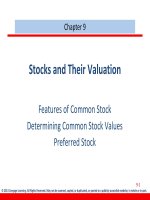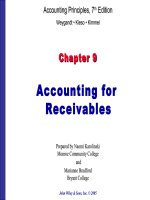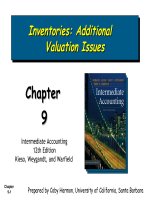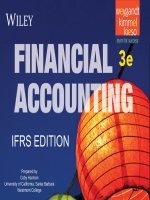Financial accounting 3e IFRS edtion willey chapter 09
Bạn đang xem bản rút gọn của tài liệu. Xem và tải ngay bản đầy đủ của tài liệu tại đây (2.9 MB, 94 trang )
WILEY
IFRS EDITION
Prepared by
Coby Harmon
University of California, Santa Barbara
9-1
Westmont College
PREVIEW OF CHAPTER 9
Financial Accounting
IFRS 3rd Edition
Weygandt ● Kimmel ● Kieso
9-2
CHAPTER
9
Plant Assets, Natural Resources, and Intangible Assets
LEARNING OBJECTIVES
After studying this chapter, you should be able to:
9-3
1.
Describe how the historical cost principle applies to plant assets.
2.
Explain the concept of depreciation and how to compute it.
3.
Distinguish between revenue and capital expenditures, and explain the entries for each.
4.
Explain how to account for the disposal of a plant asset.
5.
Compute periodic depletion of extractable natural resources.
6.
Explain the basic issues related to accounting for intangible assets.
7.
Indicate how plant assets, natural resources, and intangible assets are reported.
Plant Assets
Learning Objective 1
Describe how the
Plant assets are resources that have
historical cost principle applies to plant
assets.
physical substance (a definite size and
shape),
are used in the operations of a business,
are not intended for sale to customers,
are expected to provide service to the company for a number of years.
Referred to as property, plant, and equipment; plant and equipment; and fixed assets.
9-4
LO 1
Plant Assets
Plant assets are critical to a company’s success.
Illustration 9-1
Percentages of plant assets in relation to total assets
9-5
LO 1
Determining the Cost of Plant Assets
The historical cost principle requires that companies record plant assets at cost.
Cost consists of all expenditures necessary to acquire an asset and make it ready for its
intended use.
9-6
LO 1
Determining the Cost of Plant Assets
LAND
All necessary costs incurred in making land ready for its intended use increase (debit) the Land
account.
Costs typically include:
9-7
1)
cash purchase price,
2)
closing costs such as title and attorney’s fees,
3)
real estate brokers’ commissions,
4)
accrued property taxes and other liens assumed by the purchaser, and
5)
clearing, leveling, demo of existing structures.
LO 1
Determining the Cost of Plant Assets
Illustration: Lew Company Ltd. acquires real estate at a cash cost of HK$2,000,000. The property contains
an old warehouse that is razed at a net cost of HK$60,000 (HK$75,000 in costs less HK$15,000 proceeds
from salvaged materials). Additional expenditures are the attorney’s fee, HK$10,000, and the real estate
broker’s commission, HK$80,000.
Required: Determine the amount to be reported as the cost of the land.
9-8
LO 1
Determining the Cost of Plant Assets
Required: Determine amount to be reported as the cost of the land.
Land
Cash price of property (HK$2,000,000)
HK$2,000,000
Net removal cost of warehouse (HK$60,000)
60,000
Attorney's fees (HK$10,000)
10,000
Real estate broker’s commission (HK$80,000)
80,000
Cost of Land
HK$2,150,000
Entry to record the acquisition of the land:
Land 2,150,000
Cash
9-9
2,150,000
LO 1
Determining the Cost of Plant Assets
LAND IMPROVEMENTS
Includes all expenditures necessary to make the improvements ready for their intended use.
9-10
Examples: driveways, parking lots, fences, landscaping, and lighting.
Limited useful lives.
Expense (depreciate) the cost of land improvements over their useful lives.
LO 1
Determining the Cost of Plant Assets
BUILDINGS
Includes all costs related directly to purchase or construction.
Purchase costs:
Purchase price, closing costs (attorney’s fees, title insurance, etc.) and real estate broker’s
commission.
Remodeling and replacing or repairing the roof, floors, electrical wiring, and plumbing.
Construction costs:
9-11
Contract price plus payments for architects’ fees, building permits, and excavation costs.
LO 1
Determining the Cost of Plant Assets
EQUIPMENT
Include all costs incurred in acquiring the equipment and preparing it for use.
Costs typically include:
9-12
Cash purchase price.
Sales taxes.
Freight charges.
Insurance during transit paid by the purchaser.
Expenditures required in assembling, installing, and testing the unit.
LO 1
Determining the Cost of Plant Assets
Illustration: Zhang Company purchases factory machinery at a cash price of HK$500,000. Related
expenditures are for sales taxes HK$30,000, insurance during shipping HK$5,000, and installation and
testing HK$10,000. Compute the cost of the machinery.
Machinery
Cash price
HK$500,000
Sales taxes
30,000
Insurance during shipping
5,000
Installation and testing
10,000
Cost of Machinery
9-13
HK$545,000
LO 1
Determining the Cost of Plant Assets
Illustration: Zhang Company purchases factory machinery at a cash price of HK$500,000. Related
expenditures are for sales taxes HK$30,000, insurance during shipping HK$5,000, and installation and
testing HK$10,000. Prepare the journal entry to record these costs.
Equipment
Cash
9-14
545,000
545,000
LO 1
Determining the Cost of Plant Assets
Illustration: Huang Company purchases a delivery truck at a cash price of HK$420,000. Related expenditures
are sales taxes HK$13,200, painting and lettering HK$5,000, motor vehicle license HK$800, and a three-year
accident insurance policy HK$16,000. Compute the cost of the delivery truck.
Truck
Cash price
HK$420,000
Sales taxes
13,200
Painting and lettering
5,000
Cost of Delivery Truck
9-15
HK$438,200
LO 1
Determining the Cost of Plant Assets
Illustration: Huang Company purchases a delivery truck at a cash price of HK$420,000. Related expenditures
are sales taxes HK$13,200, painting and lettering HK$5,000, motor vehicle license HK$800, and a three-year
accident insurance policy HK$16,000. Prepare the journal entry to record these costs.
Equipment
438,200
License Expense
800
Prepaid Insurance
Cash
9-16
16,000
455,000
LO 1
ACCOUNTING ACROSS THE ORGANIZATION
Many Firms Use Leases
Leasing is big business. Who does the most leasing? AWAS (IRL), J.P. Morgan Leasing (USA), and ICBC (CHN)
are major lessors. Also, many companies have established separate leasing companies, such as Boeing Capital
Corporation (USA), Mitsubishi Heavy Industries (JPN), and John Deere Capital Corporation (USA). And, as
an excellent example of the magnitude of leasing, leased planes account for a high percentage of commercial
airlines. Leasing is also becoming more common in the hotel industry. Marriott (USA), Hilton (USA), and
InterContinental (GBR) are increasingly choosing to lease hotels that are owned by someone else.
9-17
LO 1
Depreciation
Learning Objective 2
Explain the concept
Process of allocating to expense the cost
of depreciation and
how to compute it.
of a plant asset over its useful (service) life
in a rational and systematic manner.
Process of cost allocation, not asset valuation.
Applies to land improvements, buildings, and equipment, not land.
Depreciable, because the revenue-producing ability of asset will decline over the asset’s useful
life.
9-18
LO 2
Depreciation
Question
Depreciation is a process of:
9-19
a.
valuation.
b.
cash accumulation.
c.
cost allocation.
d.
appraisal.
LO 2
FACTORS IN COMPUTING DEPRECIATION
Illustration 9-6
Three factors in computing depreciation
• HELPFUL HINT
Depreciation expense is reported on the income statement.
Accumulated depreciation is reported on the balance sheet as a
deduction from plant assets.
9-20
LO 2
DEPRECIATION METHODS
Management selects the method it believes best measures an asset’s contribution to revenue over its
useful life.
Examples include:
9-21
(1)
Straight-line method
(2)
Units-of-activity method
(3)
Declining-balance method
LO 2
DEPRECIATION METHODS
Illustration: Bob’s Florist purchased a small delivery truck on January 1, 2017.
Cost
Expected residual value
€13,000
€1,000
Estimated useful life in years
5
Estimated useful life in miles
100,000
Required: Compute depreciation using the following.
(a) Straight-Line. (b) Units-of-Activity. (c) Declining-Balance.
9-22
LO 2
STRAIGHT-LINE METHOD
Expense is same amount for each year.
Depreciable cost = Cost less salvage value.
ILLUSTRATION 9-8
Formula for straight-line method
9-23
LO 2
STRAIGHT-LINE METHOD
Illustration 9-9
Illustration:
Straight-line depreciation
schedule
2017
€ 12,000
2018
12,000
2019
€ 2,400
€ 2,400
€ 10,600
20
2,400
4,800
8,200
12,000
20
2,400
7,200
5,800
2020
12,000
20
2,400
9,600
3,400
2021
12,000
20
2,400
12,000
1,000
2017
Journal Entry
9-24
Depreciation Expense
20%
2,400
Accumulated Depreciation
2,400
LO 2
STRAIGHT-LINE METHOD
Partial Year
Illustration:
Assume the delivery truck was purchased on April 1, 2017.
9-25
LO 2









